There are more than 100 species of Nepenthes in the wild. They mostly grow in Borneo, but also in Asia and Australia. The Nepenthes genus was given its name by Carl von Linné (Linnaeus) in 1737.
Nepenthes plants are characterised by the pitchers they form on their petioles. In some species, the pitchers can grow up to 35 cm long. They contain a liquid digestive enzyme that dissolves insects that get trapped when they are attracted by the nectar along the edge of the pitcher. When insects settle on the pitcher edge they slide down into it, and are drowned and digested. The lid of the pitcher acts like an umbrella, to prevent the pitcher filling up with too much rainwater. Nepenthes likes a fine spray of rainwater as necessary, and if it is being grown in dry air, it will need spraying more frequently – at least once a week. Nepenthes plants are best suited to locations with slightly higher humidity than a living room, or where there are already many plants. Kitchens and bathrooms are also possible habitats.
Location: Cannot tolerate direct sunlight. Prefers a shady spot with high humidity.
Cultivation: Normally no fertiliser, but if the plant has light-coloured leaves a small amount of fertiliser may be applied. It should be watered very sparsely but kept constantly moist, and must not dry out. It is best watered with rainwater.

Nepenthes Alata 9 cm (143)

Nepenthes Gaya (144)

Nepenthes Hookeriana 9 cm (146)

Nepenthes Sanguinea hybrid 9 cm (147)

Ampel 15 cm MIX (172)

Ampel Alata (174)

Ampel Gaya (175)

Ampel Sanguinea hybrid (176)
-

Nepenthes Alata 9 cm (143)
-

Nepenthes Gaya (144)
-

Nepenthes Hookeriana 9 cm (146)
-

Nepenthes Sanguinea hybrid 9 cm (147)
-

Ampel 15 cm MIX (172)
-

Ampel Alata (174)
-

Ampel Gaya (175)
-

Ampel Sanguinea hybrid (176)

